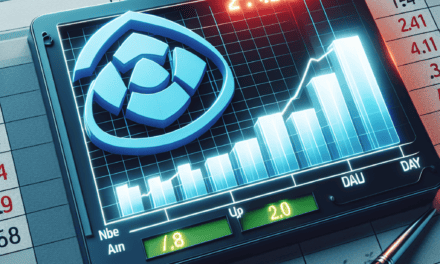“Wall Street Wavers: Strong US Economy Stifles Hopes for Rate Cuts.”
Introduction
Wall Street experienced another decline as investors grappled with the implications of a robust U.S. economy on future monetary policy. Strong economic indicators, including solid job growth and rising consumer spending, have led to speculation that the Federal Reserve may hold off on interest rate cuts. This uncertainty has fueled concerns among traders, resulting in a sell-off across major indices. As market participants reassess their strategies in light of these developments, the outlook for equities remains cautious amid the backdrop of a resilient economic landscape.
Wall Street’s Reaction to Economic Data
Wall Street’s reaction to recent economic data has been marked by a notable decline, reflecting the complexities of the current financial landscape. As investors digest the implications of a robust U.S. economy, concerns about the potential for interest rate cuts have intensified. The latest reports indicate that key economic indicators, such as employment figures and consumer spending, have surpassed expectations, leading to a reevaluation of monetary policy by the Federal Reserve. This robust performance, while indicative of a healthy economy, has simultaneously raised alarms about the sustainability of such growth and the implications for interest rates.
In light of this data, market participants have begun to recalibrate their expectations regarding future rate cuts. Previously, there was a prevailing sentiment that the Federal Reserve might ease monetary policy in response to signs of economic slowdown. However, the recent economic indicators suggest that the economy is not only resilient but also capable of withstanding potential headwinds. Consequently, the prospect of rate cuts has dimmed, leading to a sell-off in equities as investors reassess their positions in anticipation of a more hawkish stance from the central bank.
Moreover, the decline in stock prices can be attributed to a broader concern about inflationary pressures. As the economy continues to expand, the risk of rising prices becomes more pronounced. Investors are acutely aware that sustained inflation could compel the Federal Reserve to maintain or even increase interest rates, which would further dampen market sentiment. This interplay between economic growth and inflation creates a challenging environment for investors, who must navigate the delicate balance between potential returns and the risks associated with higher borrowing costs.
Additionally, the reaction on Wall Street has been influenced by sector-specific dynamics. For instance, technology stocks, which have been a significant driver of market gains in recent years, have faced increased scrutiny as interest rates remain elevated. Higher rates can disproportionately affect growth-oriented sectors, leading to a reevaluation of valuations and future earnings potential. As a result, investors have shifted their focus toward more defensive sectors, seeking stability amid the uncertainty surrounding monetary policy.
Furthermore, the global economic landscape adds another layer of complexity to Wall Street’s reaction. Geopolitical tensions, supply chain disruptions, and varying recovery trajectories across different regions have all contributed to market volatility. Investors are increasingly aware that domestic economic strength does not exist in a vacuum; rather, it is intertwined with global economic conditions. This interconnectedness means that any signs of weakness abroad could have ripple effects on U.S. markets, further complicating the outlook for equities.
In conclusion, Wall Street’s recent decline underscores the intricate relationship between economic data and market sentiment. As the U.S. economy demonstrates resilience, the prospects for interest rate cuts have diminished, leading to a cautious approach among investors. The interplay of inflation concerns, sector-specific dynamics, and global economic factors creates a challenging environment for market participants. As they navigate these complexities, investors must remain vigilant, adapting their strategies to the evolving economic landscape while keeping a close eye on the Federal Reserve’s policy decisions. Ultimately, the path forward will require a careful balancing act between optimism for economic growth and the realities of monetary policy constraints.
The Impact of Interest Rates on Market Performance
The relationship between interest rates and market performance is a fundamental aspect of economic analysis, particularly in the context of a robust economy. As the U.S. economy continues to demonstrate resilience, characterized by strong consumer spending, low unemployment rates, and steady GDP growth, the implications for interest rates become increasingly significant. Investors closely monitor the actions of the Federal Reserve, as changes in interest rates can have profound effects on market dynamics. When the economy is performing well, the likelihood of interest rate cuts diminishes, leading to a cautious sentiment among investors.
In a thriving economic environment, the Federal Reserve often opts to maintain or even increase interest rates to prevent overheating and inflation. This decision is rooted in the belief that a strong economy can sustain higher borrowing costs without stifling growth. Consequently, when the Fed signals its intention to keep rates steady or raise them, market participants may react negatively, fearing that higher interest rates will dampen corporate profits and consumer spending. This reaction was evident in recent declines on Wall Street, where investors grappled with the implications of a robust economy on future monetary policy.
Moreover, higher interest rates can lead to increased borrowing costs for both consumers and businesses. As loans become more expensive, consumer spending may slow, which in turn can affect corporate earnings. Companies that rely heavily on debt financing may find their profit margins squeezed, leading to a reassessment of their growth prospects. This interconnectedness between interest rates and corporate performance underscores the importance of monitoring economic indicators that influence Fed policy decisions. For instance, strong job growth and rising wages can signal to the Fed that the economy is robust enough to withstand higher rates, further complicating the outlook for equity markets.
Additionally, the bond market often reacts to changes in interest rate expectations, which can create ripple effects across various asset classes. When interest rates rise, bond yields typically increase, making fixed-income investments more attractive relative to equities. As a result, investors may shift their portfolios away from stocks and into bonds, leading to downward pressure on stock prices. This shift can be particularly pronounced in sectors that are sensitive to interest rate changes, such as utilities and real estate, which often rely on cheap debt for expansion and operations.
Furthermore, the psychological aspect of interest rate changes cannot be overlooked. Investor sentiment plays a crucial role in market performance, and uncertainty regarding future rate hikes can lead to increased volatility. As market participants digest economic data and Fed communications, their expectations can shift rapidly, resulting in sharp market movements. This volatility can create challenges for investors, who must navigate the complexities of both macroeconomic indicators and central bank policies.
In conclusion, the interplay between interest rates and market performance is a critical consideration for investors, particularly in the context of a strong U.S. economy. As the Federal Reserve weighs its options regarding monetary policy, the potential for sustained higher interest rates looms large, influencing investor behavior and market dynamics. Understanding this relationship is essential for making informed investment decisions, as the implications of interest rate changes extend far beyond the immediate effects on borrowing costs. Ultimately, as Wall Street grapples with these challenges, the broader economic landscape will continue to shape the trajectory of financial markets.
Analyzing the Resilience of the US Economy
The resilience of the US economy has become a focal point for analysts and investors alike, particularly in light of recent fluctuations in the stock market. As Wall Street experiences declines, the underlying strength of economic indicators suggests a complex relationship between growth and monetary policy. The current economic landscape is characterized by robust consumer spending, a tight labor market, and persistent inflationary pressures, all of which contribute to the Federal Reserve’s cautious stance on interest rate cuts.
Consumer spending, which accounts for a significant portion of the US GDP, has shown remarkable durability despite rising interest rates. This spending is bolstered by a strong labor market, where unemployment rates remain near historic lows. The availability of jobs and wage growth have empowered consumers, allowing them to maintain their purchasing power even in the face of higher prices. Consequently, this sustained consumer activity has led to increased demand for goods and services, further fueling economic growth. However, this growth has not come without challenges, as inflation continues to pose a threat to the purchasing power of consumers.
Moreover, the labor market’s resilience is evident in the steady job creation figures reported in recent months. Employers are actively seeking talent, which has resulted in a competitive job market. This competition has not only driven wages higher but has also contributed to a sense of job security among workers. As a result, consumer confidence remains elevated, encouraging spending and investment. However, the tight labor market also raises concerns about wage inflation, which could compel the Federal Reserve to maintain or even increase interest rates to curb inflationary pressures.
In addition to consumer spending and labor market dynamics, the manufacturing sector has displayed signs of resilience as well. While some sectors have faced headwinds due to global supply chain disruptions and geopolitical tensions, others have adapted by investing in technology and innovation. This adaptability has allowed certain industries to thrive, contributing to overall economic stability. Nevertheless, the manufacturing sector’s performance is closely tied to global economic conditions, and any significant downturns abroad could have ripple effects on the US economy.
As the Federal Reserve navigates this complex economic landscape, its decisions regarding interest rates will be critical. The central bank’s dual mandate of promoting maximum employment and stable prices requires a delicate balance. While the current economic indicators suggest strength, the persistent inflationary environment complicates the Fed’s ability to implement rate cuts. Investors are acutely aware of this dynamic, leading to increased volatility in the stock market as they reassess their expectations for future monetary policy.
In conclusion, the resilience of the US economy is evident through strong consumer spending, a robust labor market, and adaptive manufacturing sectors. However, the interplay between these factors and inflationary pressures creates a challenging environment for policymakers. As Wall Street reacts to these developments, the prospect of interest rate cuts appears dim, underscoring the importance of closely monitoring economic indicators. The ongoing dialogue between economic growth and monetary policy will undoubtedly shape the trajectory of the US economy in the months to come, making it essential for investors and analysts to remain vigilant in their assessments.
Investor Sentiment Amidst Market Volatility
Investor sentiment has been notably affected by the recent fluctuations in the stock market, particularly as Wall Street experiences another decline amid concerns surrounding the robust state of the U.S. economy. This downturn has prompted a reevaluation of expectations regarding interest rate cuts, which had previously been anticipated by many market participants. As economic indicators continue to reflect strength, the prospect of the Federal Reserve maintaining or even increasing interest rates has become more pronounced, leading to a palpable shift in investor attitudes.
In light of these developments, many investors are grappling with uncertainty. The strong performance of the labor market, coupled with resilient consumer spending, has raised questions about the sustainability of the current economic expansion. Consequently, this has led to a reassessment of the Federal Reserve’s monetary policy trajectory. Investors who had positioned themselves for potential rate cuts are now faced with the reality that such actions may be delayed or entirely off the table, given the prevailing economic conditions. This shift in expectations has contributed to increased volatility in the markets, as participants react to new information and adjust their strategies accordingly.
Moreover, the decline in stock prices can be attributed to a broader concern regarding inflationary pressures. As the economy continues to show signs of strength, inflation remains a critical factor that the Federal Reserve must contend with. The central bank’s dual mandate of promoting maximum employment and stable prices means that it must carefully navigate the delicate balance between fostering growth and curbing inflation. As a result, investors are becoming increasingly cautious, weighing the implications of potential rate hikes against the backdrop of a strong economy.
In this context, market volatility has become a defining characteristic of the current investment landscape. Many investors are adopting a more defensive posture, seeking to mitigate risk in an environment where interest rate uncertainty looms large. This shift is evident in the rotation towards sectors that are perceived as more resilient during periods of rising rates, such as utilities and consumer staples. Conversely, growth-oriented sectors, which typically benefit from lower interest rates, have faced increased selling pressure as investors recalibrate their expectations.
Furthermore, the psychological impact of market declines cannot be understated. As stock prices fluctuate, investor confidence can wane, leading to a cycle of selling that exacerbates market volatility. This phenomenon is particularly pronounced in an environment where news headlines and economic data releases can trigger swift reactions from market participants. Consequently, the interplay between investor sentiment and market dynamics becomes increasingly complex, as emotions often drive decision-making in the face of uncertainty.
As investors navigate this challenging landscape, it is essential to remain informed and adaptable. The ability to respond to changing economic conditions and adjust investment strategies accordingly will be crucial in mitigating risks and capitalizing on potential opportunities. While the current environment may be fraught with challenges, it also presents a chance for investors to reassess their portfolios and consider long-term strategies that align with their financial goals.
In conclusion, the recent decline in Wall Street reflects a broader sentiment of caution among investors, driven by the robust state of the U.S. economy and the implications for interest rate policy. As market volatility persists, maintaining a balanced perspective and a focus on long-term objectives will be vital for navigating the complexities of the current investment landscape.
Future Projections for Rate Cuts and Market Trends
As Wall Street grapples with the implications of a robust U.S. economy, the prospect of interest rate cuts appears increasingly dim. Recent economic indicators, including strong job growth and resilient consumer spending, have led many analysts to reassess their expectations for monetary policy adjustments by the Federal Reserve. This shift in sentiment is particularly significant given the backdrop of previous discussions surrounding potential rate cuts aimed at stimulating economic activity. However, the current economic landscape suggests that such measures may not be necessary in the near term.
In light of the latest economic data, market participants are recalibrating their forecasts. The Federal Reserve has consistently emphasized its commitment to maintaining price stability while fostering maximum employment. As inflation remains above the central bank’s target, the likelihood of rate cuts diminishes. Consequently, investors are beginning to adjust their strategies, anticipating a prolonged period of higher interest rates. This adjustment is reflected in the recent volatility observed in equity markets, as traders react to the evolving economic narrative.
Moreover, the bond market is also responding to these developments. Yields on government securities have risen, signaling that investors are demanding higher returns in an environment where rate cuts are less likely. This shift in bond yields can have a cascading effect on various asset classes, influencing everything from mortgage rates to corporate borrowing costs. As a result, companies may face increased pressure to manage their debt levels, which could impact their growth strategies and overall market performance.
In addition to these financial dynamics, the global economic landscape plays a crucial role in shaping future projections for rate cuts. Geopolitical tensions, supply chain disruptions, and varying recovery trajectories among major economies contribute to an uncertain outlook. For instance, if international markets experience a slowdown, it could have ripple effects on U.S. exports and corporate earnings, potentially prompting a reassessment of monetary policy. However, as it stands, the strength of the domestic economy appears to be a counterbalancing force, complicating the Fed’s decision-making process.
Furthermore, the labor market remains a focal point for policymakers. With unemployment rates at historically low levels and wage growth showing signs of acceleration, the Fed may feel less inclined to implement rate cuts. A tight labor market often leads to increased consumer spending, which can further bolster economic growth. However, this scenario also raises concerns about inflationary pressures, as higher wages can translate into increased costs for businesses, potentially leading to higher prices for consumers.
As we look ahead, it is essential to consider how these factors will influence market trends. Investors may need to adopt a more cautious approach, focusing on sectors that are less sensitive to interest rate fluctuations. Additionally, the potential for continued volatility in equity markets may prompt a flight to quality, with investors seeking refuge in more stable assets. Ultimately, while the prospect of rate cuts may have dimmed, the interplay between economic indicators, monetary policy, and market sentiment will continue to shape the financial landscape.
In conclusion, the current state of the U.S. economy presents a complex picture for future projections regarding interest rate cuts. As Wall Street navigates this evolving environment, it is crucial for investors to remain vigilant and adaptable, recognizing that the interplay of various economic factors will ultimately dictate market trends in the months to come.
Sector Performance During Economic Uncertainty
As Wall Street grapples with the implications of a robust U.S. economy, the performance of various sectors during this period of economic uncertainty has become a focal point for investors and analysts alike. The recent decline in major indices reflects a growing concern that the strength of economic indicators may diminish the likelihood of interest rate cuts by the Federal Reserve. This situation has led to a reevaluation of sector performance, as different industries respond uniquely to the prevailing economic climate.
In the face of rising interest rates, the technology sector has experienced notable volatility. Historically, technology stocks have thrived in low-interest-rate environments, where cheap borrowing costs fuel innovation and expansion. However, as the prospect of rate cuts diminishes, investors are becoming increasingly cautious. This caution is evident in the fluctuating stock prices of major tech companies, which have seen a mix of gains and losses as market sentiment shifts. Consequently, while some investors remain optimistic about long-term growth potential, others are reassessing their positions, leading to a more cautious approach in this sector.
Conversely, the financial sector has shown resilience amid these economic uncertainties. Banks and financial institutions typically benefit from higher interest rates, as they can charge more for loans while maintaining lower rates on deposits. As the economy continues to demonstrate strength, financial stocks have generally performed well, reflecting investor confidence in their ability to navigate a potentially higher-rate environment. This sector’s performance underscores the complex interplay between interest rates and economic health, as financial institutions position themselves to capitalize on the opportunities presented by a robust economy.
Meanwhile, the consumer discretionary sector has faced its own set of challenges. As inflationary pressures persist, consumers may become more cautious with their spending, particularly on non-essential goods and services. This shift in consumer behavior can significantly impact companies within this sector, leading to a divergence in performance among retailers and service providers. While some companies may adapt successfully to changing consumer preferences, others may struggle to maintain their market positions, highlighting the importance of agility and innovation in navigating economic uncertainty.
In contrast, the consumer staples sector has demonstrated relative stability during this period. Companies that produce essential goods, such as food and household products, tend to be less sensitive to economic fluctuations. As consumers prioritize necessities over discretionary spending, this sector often benefits from consistent demand, providing a safe haven for investors seeking stability amid market volatility. The resilience of consumer staples underscores the notion that certain sectors can thrive even when broader economic conditions appear uncertain.
Moreover, the energy sector has also been influenced by the current economic landscape. With fluctuating oil prices and geopolitical tensions, energy companies are navigating a complex environment. While a strong economy can drive demand for energy, the potential for rising interest rates may temper investment in new projects. As a result, energy stocks have exhibited mixed performance, reflecting the dual pressures of economic growth and interest rate expectations.
In summary, the performance of various sectors during this period of economic uncertainty illustrates the intricate dynamics at play in the market. As Wall Street continues to react to the implications of a robust U.S. economy and the dimming prospects for rate cuts, investors must remain vigilant in assessing how different industries respond to these evolving conditions. Understanding these sector-specific trends will be crucial for making informed investment decisions in an increasingly complex financial landscape.
Strategies for Navigating a Declining Market
As Wall Street experiences another decline amid concerns over the robust state of the U.S. economy, investors are faced with the challenge of navigating a market that appears increasingly volatile. The recent economic indicators, which suggest sustained growth and resilience, have led to speculation that the Federal Reserve may be less inclined to implement rate cuts in the near future. This situation creates a complex environment for investors, necessitating the adoption of strategic approaches to mitigate risks and capitalize on potential opportunities.
One effective strategy for navigating a declining market is diversification. By spreading investments across various asset classes, sectors, and geographic regions, investors can reduce their exposure to any single economic downturn. This approach not only helps to cushion the impact of market fluctuations but also positions investors to benefit from sectors that may perform well even in challenging economic conditions. For instance, while technology stocks may be under pressure, sectors such as utilities or consumer staples could provide stability and consistent returns.
In addition to diversification, maintaining a long-term perspective is crucial during periods of market decline. Investors often feel compelled to react to short-term market movements, which can lead to impulsive decisions that may not align with their overall financial goals. By focusing on long-term objectives and adhering to a well-thought-out investment strategy, individuals can avoid the pitfalls of emotional trading. This approach encourages investors to remain committed to their investment plans, even when faced with market volatility, thereby increasing the likelihood of achieving their financial aspirations over time.
Moreover, it is essential for investors to stay informed about economic trends and market dynamics. Understanding the broader economic landscape can provide valuable insights into potential market movements and help investors make informed decisions. For instance, keeping an eye on inflation rates, employment figures, and consumer spending can offer clues about the Federal Reserve’s potential actions regarding interest rates. By staying abreast of these developments, investors can better anticipate market shifts and adjust their strategies accordingly.
Another important consideration is the potential for tactical asset allocation. In a declining market, it may be prudent to shift allocations toward more defensive investments, such as bonds or dividend-paying stocks, which tend to be less sensitive to economic fluctuations. This strategy can help preserve capital while still providing opportunities for income generation. Additionally, investors might explore alternative investments, such as real estate or commodities, which can offer diversification benefits and act as a hedge against inflation.
Furthermore, employing risk management techniques is vital in a declining market. Setting stop-loss orders can help limit potential losses by automatically selling a security when it reaches a predetermined price. This proactive approach allows investors to protect their portfolios from significant downturns while maintaining the flexibility to re-enter the market when conditions improve. Additionally, regularly reviewing and rebalancing portfolios ensures that asset allocations remain aligned with individual risk tolerance and investment objectives.
In conclusion, while the current decline in Wall Street may present challenges, it also offers opportunities for those who are prepared to navigate the complexities of the market. By embracing diversification, maintaining a long-term perspective, staying informed, considering tactical asset allocation, and implementing risk management strategies, investors can position themselves to weather the storm and emerge stronger when the market eventually rebounds. Ultimately, a disciplined and informed approach will be key to successfully navigating the uncertainties of a declining market.
Q&A
1. **Question:** What recent trend has Wall Street experienced?
**Answer:** Wall Street has experienced a decline.
2. **Question:** What is the primary reason for the decline in Wall Street?
**Answer:** The decline is attributed to a robust US economy that dims prospects for interest rate cuts.
3. **Question:** How does a strong economy affect interest rate cut expectations?
**Answer:** A strong economy typically leads to expectations of higher interest rates rather than cuts, as the Federal Reserve may aim to control inflation.
4. **Question:** What impact does the prospect of higher interest rates have on the stock market?
**Answer:** Higher interest rates can lead to reduced borrowing and spending, which may negatively impact corporate profits and stock prices.
5. **Question:** Which sectors are most affected by rising interest rates?
**Answer:** Sectors such as utilities, real estate, and consumer discretionary are often most affected by rising interest rates.
6. **Question:** What indicators suggest the US economy is performing robustly?
**Answer:** Indicators such as strong employment figures, GDP growth, and consumer spending suggest a robust US economy.
7. **Question:** What might investors look for in response to the current market conditions?
**Answer:** Investors may look for safer assets or sectors that perform well in a high-interest-rate environment, such as value stocks or commodities.
Conclusion
The recent decline on Wall Street reflects investor concerns over the implications of a strong US economy, which diminishes the likelihood of interest rate cuts by the Federal Reserve. As economic indicators suggest resilience, market participants are recalibrating their expectations for monetary policy, leading to increased volatility and a cautious outlook for equities. This situation underscores the delicate balance between economic growth and interest rate adjustments, influencing market sentiment and investment strategies moving forward.





